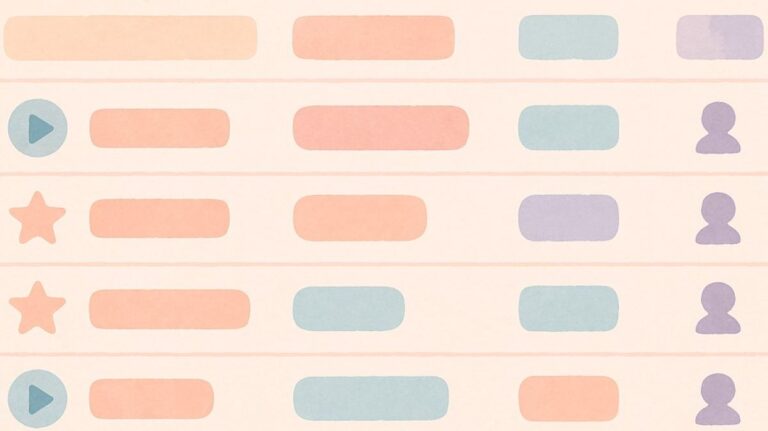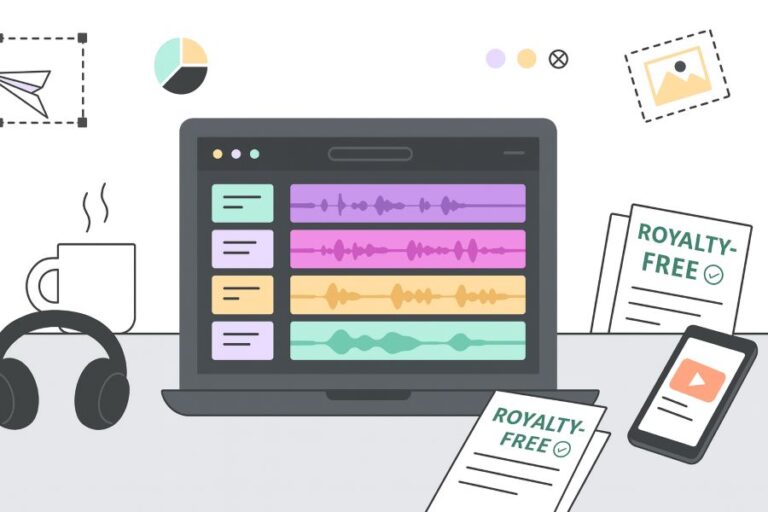Why Royalty-free Music for TikTok Beats In-app Sounds
Audiodrome is a royalty-free music platform designed specifically for content creators who need affordable, high-quality background music for videos, podcasts, social media, and commercial projects. Unlike subscription-only services, Audiodrome offers both free tracks and simple one-time licensing with full commercial rights, including DMCA-safe use on YouTube, Instagram, and TikTok. All music is original, professionally produced, and PRO-free, ensuring zero copyright claims. It’s ideal for YouTubers, freelancers, marketers, and anyone looking for budget-friendly audio that’s safe to monetize.
TikTok’s sounds feel convenient until you try to boost a winner, send it to a client, or move it across platforms. Royalty-free music for TikTok turns your soundtrack into proof-backed, portable rights instead of borrowed noise that can vanish the moment rules or deals change.
Cross-platform proof: one license that actually travels with your video
In-app sounds, including TikTok’s Commercial Music Library, sit inside TikTok’s own licensing deals, and those rights stop at the platform edge. The moment you download or repurpose that edit for Reels, Shorts, or YouTube, you leave that comfort zone, and your coverage no longer applies.

TikTok expects brands and serious creators to treat music outside its app as their own responsibility and to secure direct licenses when they publish on other platforms. If you want one video to live safely on TikTok, Instagram, YouTube, and beyond, you need that permission yourself.
A properly written royalty-free license with multi-platform coverage lets you keep one master edit that travels wherever your strategy needs it. You save your team from constant re-edits, avoid muted clips and random claims, and turn your soundtrack into a stable asset instead of a guess.
Immunity to TikTok label disputes and catalog removals
When TikTok and a major label fall out or a deal expires, songs can disappear overnight, and videos lose their sound without prior notice. That risk comes from platform-level blanket deals that shift based on negotiations, creators and brands never see or control.

If you license royalty-free tracks directly from a catalog that grants usage rights to you, your permission lives in that contract instead of TikTok’s changing deals. Your audio stays intact even if TikTok mutes catalog songs, trims its library, or tests new restrictions in the background.
Real paperwork: you can prove you’re allowed to use the track
With native sounds, you do not get a personalized license or contract in your name, only TikTok’s general terms. That weak proof crumbles fast when a brand partner, MCN, platform rep, or advertiser asks you to show who owns the rights behind your soundtrack.
A focused royalty-free library gives you an invoice and license document that lists platforms, commercial rights, duration, and any ad use in clear language. You can answer questions in seconds, attach the file to approvals, and defend your videos when someone challenges your audio.
TikTok sounds are overused, and RF music keeps your content distinct
Trending TikTok sounds spread fast across millions of videos, so viewers scroll through the same hooks again and again. When you drop a brand spot or paid message on top of that, your work feels like another copy of the trend and fades into the noise.

A curated royalty-free track lets you shape a sound that belongs to your brand instead of the algorithm. You repeat that track or family of tracks across TikTok, Reels, Shorts, and ads, so people start to recognize you by ear before they even see the logo.
Safe for real ads, Spark Ads, allowlisting, and UGC deals
The moment a post promotes a brand, product, or service, TikTok treats it as commercial use and expects you to follow stricter music rules. TikTok points brands toward the Commercial Music Library or properly licensed tracks and tells you to confirm rights if you bring in external music.

Royalty-free music that clearly covers ads, sponsored posts, Spark Ads, allowlisting, and UGC campaigns turns that guidance into something you can actually rely on. You protect your media budget from mutes and disputes, keep clients safe, and run one approved soundtrack across every format without guesswork.
No geo-blocking or territory surprises
TikTok limits parts of its catalog, including Commercial Music Library tracks, to specific countries, so a song that works on your device can show a region error or a silent clip for viewers elsewhere. That mismatch breaks campaigns that need one clear message and one soundtrack across all markets.

A solid royalty-free license that states worldwide social media use keeps your audio consistent for every audience you target. You avoid hidden carve-outs, protect launches in new regions, and keep legal teams calm by matching one global creative idea with one globally cleared track.
Freedom to edit, loop, and build a sonic identity
In-app sounds lock you into short, fixed snippets that fit a trend more than your brand. If you stretch, chop, or repurpose them too far, you step outside what TikTok intended, and your soundtrack starts to feel unstable for serious campaigns.
Royalty-free tracks give you room to cut, loop, fade, or build custom intros and outros without new legal doubts. You shape a repeatable sound system for TikTok, Reels, Shorts, and ads, so every edit points back to one clear, owned sonic identity.
Scales better for agencies and multi-brand workflows
Agencies that manage multiple brands across TikTok, Reels, Shorts, and YouTube handle so many trends that no one can track the status of every sound. That pressure creates constant friction with legal teams, who read TikTok only terms as vague, inconsistent, and impossible to roll out across all clients.
A vetted royalty-free catalog with clear commercial and multi-platform rights lets teams run one set of rules for every client and every channel. Producers, editors, and account managers know exactly which tracks they can use, which documents to attach, and how to protect campaigns without slowing creative work.
Future-proof against new monetization rules
As TikTok introduces tools like Music Usage Confirmation and updates Commercial Music Library guidance, it keeps raising the bar on how clearly creators prove their music rights. If your catalog relies only on in-app sounds, each policy change can hit views, monetization, and brand approvals without much warning.

Royalty-free tracks with perpetual or long-term rights give your content a stable legal base even when TikTok adjusts terms or renegotiates with rights holders. Your existing videos stay covered, new rules trigger fewer emergencies, and your revenue strategy grows on contracts you control instead of shifting platform rules.
Subscription vs. One-off RF Libraries
The right model should fit your posting rhythm, your ad plans, and your need to reuse the same edit across TikTok, Reels, Shorts, YouTube, and paid placements without re-cutting audio.
Subscription-based libraries (Epidemic, Artlist, etc.)
Subscription models give you broad access while you pay. You usually pay monthly or yearly for a large catalog, and you can use tracks under the rules of that plan during the active term.

When the subscription ends, new uses stop. Many services promise ongoing coverage for videos created while the subscription was active, which suits TikTok plus cross-posting. Others limit perpetual validity or tie the license to named channels, which creates friction for agencies, UGC deliverables, and allowlisting deals.

Plans often separate creator use from commercial work. Read for explicit language on client projects, paid ads, Spark Ads, and platform lists so you know your edits will hold up when you boost them or hand them to a brand partner.

You will see different approaches across well-known providers such as PremiumBeat, Pond5, Artlist, and LucidSamples. Treat their marketing pages as a starting point and rely on the actual license agreement because that document governs what you can prove later.
Subscriptions shine when you publish often and need a steady stream of fresh tracks. Daily creators, social teams, and agencies running always-on calendars get speed and variety without negotiating a new license every time.
The biggest risk comes from assumptions. If the license does not say that published videos keep their rights and that ads are allowed across platforms, people recreate the same TikTok-only problem inside a subscription and discover the gap when a copyright claim lands.
One-off royalty-free licenses (pay-per-track & collections you can lock in)
One-off licenses give you a buy-it-once path that can anchor a campaign or brand theme. You select a track or collection, pay a single fee, and receive a license that spells out where and how you can use the music.






Strong one-off licenses often grant perpetual rights for the listed uses and cover social platforms worldwide. Many also support a wide range of media types, meaning the same track can live on TikTok, Reels, Shorts, YouTube, and your site if the document says so.
This matters when you compare royalty-free music for TikTok against in-app sounds. You can pick a hero track, know it is not tied to TikTok’s catalog deals, and move the same edit across platforms and ads with confidence because you can show a concrete license or invoice on request.
The cost picture can also favor a one-off. Evergreen campaigns, signature intros, and long-running series often spend less with a single perpetual license than with an ongoing subscription, especially when you only need one or two tracks that define your sound.

Read the fine print with care because a one-off is only as strong as its terms. If social, ads, UGC delivery, allowlisting, or client work are missing, the license will not protect you when a platform or partner asks for proof.
Marketplaces that accept contributor uploads deserve extra diligence. Ask how they vet ownership, how they handle wrongful claims, and if they help clear disputes, then keep the license document handy so you can resolve issues quickly when something flags.
The Agreement / License / Fine Print / Document: What It Must Cover
Your advantage over TikTok in-app sounds starts here: a clear, written license that proves what you can do, on which platforms, for how long, and under whose name.
Who is licensed
Every license needs a real person or legal entity on it, not just a logo or vague account name. Use your correct business name, creator name, or agency name so you can match invoices, contracts, and platform accounts when someone checks.

If you run an agency, confirm in writing that your license covers client projects or only your own channels. If clients need separate licenses, build that into your workflow before you launch a campaign instead of fixing angry emails after a takedown.
This detail decides how safe your campaigns feel when lawyers join the call. Brands, MCNs, and platforms often ask who holds the rights, and a generic library name or only TikTok’s user terms does not prove that you, your client, or your brand actually sit inside the license.
Which tracks are covered
Your document should tell you exactly what you paid for. That can mean specific track titles and IDs, a named collection, or a clause that clearly covers all tracks you used while your subscription remained active.

When a claim hits, clarity on track identity shuts down guesswork. You can point to a line that ties that exact song to your license instead of arguing in support tickets if a random “TikTok sound” counted as legal.
Scope of use: platforms and formats
The license must spell out where your music can live, not hint at it. Look for explicit mention of TikTok, Instagram Reels, YouTube Shorts, long-form YouTube, and paid campaigns such as TikTok Ads, Meta Ads, YouTube Ads, Spark Ads, and creator allowlisting.
If you publish in other places, check the same page for websites, landing pages, organic social feeds, podcasts, mobile apps, OTT placements, digital signage, or broadcast. A strong license keeps your hero tracks consistent across every surface where your brand shows up.

Many serious royalty-free providers now list supported platforms and ad types in plain language, including how they treat client work and sponsored content. If TikTok, cross-posting, or paid media rights never appear, treat that silence as a problem, not an accident.
Territory
Good modern licenses keep things simple and say worldwide. If the agreement limits territories, it should do that clearly so you know where your soundtracks stay safe and where you need a different solution.

This point separates proper licenses from TikTok in-app sounds, where label deals and music availability can shift by region. When your royalty-free terms say worldwide, you avoid the surprise of muted or replaced audio for part of your audience.
Duration
Check how long your rights last instead of assuming they never end. Some deals cover you only while the subscription stays active, while others grant perpetual rights for projects you publish during a valid term.

For TikTok content that you plan to reuse, feature, or boost later, perpetual coverage for already published videos matters more than you think. It protects your archive when budgets change or subscriptions pause.
Type of use: commercial vs personal
The license should clearly allow commercial activity if you run any kind of business or brand. Look for language that covers client work, sponsored posts, product pushes, affiliate content, ad campaigns, and monetization programs on platforms instead of a vague promise for “regular videos.”

Editing, adaptations, and sync
You need explicit permission to sync the music with the video and to edit it in natural ways. Look for language that allows cutting, looping, fading, voiceover, intros and outros, and multiple edits of the same project without buying fresh rights each time.

If a provider limits remixes, stems, or other adaptations, the license should say that clearly. When you understand those limits upfront, you can pick tracks that match your creative process instead of discovering restrictions after delivery.
Third-party claims and takedowns
Content ID hits and wrongful claims happen, so your license should say how the provider supports you. Good partners explain their claim process, offer documentation, and give you a clear route to release a claim quickly.

Indemnification, or at least hands-on assistance, shows that the library stands behind its catalog. With TikTok in-app sounds, you usually accept whatever enforcement lands, while a documented royalty-free license gives you leverage and a support path.
Proof you can show partners and platforms
Make sure you can download or request a visible record of your rights. License certificates, invoices that list your plan, or dashboard entries linked to your account create a paper trail you can share.

A unique link, reference number, or named document lets you respond fast when a platform, network, or brand team asks for proof. That response keeps your video online and shows that you run music use like a professional, not on hope.
Revocation and changes
Every provider reserves the right to change terms, so look at how they describe it. Focus on how they handle catalog removals, policy updates, and subscription changes, especially for content you have already published.

Confirm that your existing projects stay licensed if they pull a track or update conditions. If that protection does not appear, you carry the risk that a routine catalog change can break your campaign.
A solid royalty-free setup states in plain language that projects created under valid terms keep their rights. That commitment turns your music choices into assets you can trust when you scale beyond TikTok in-app sounds.
Make Your Soundtrack Work As Hard As Your Strategy
Royalty-free music is an operations upgrade. When your tracks come with clear documents, stable rights, and room to scale across platforms, every edit you publish keeps working, instead of waiting for the next mute, block, or awkward email.

Audiodrome was created by professionals with deep roots in video marketing, product launches, and music production. After years of dealing with confusing licenses, inconsistent music quality, and copyright issues, we set out to build a platform that creators could actually trust.
Every piece of content we publish is based on real-world experience, industry insights, and a commitment to helping creators make smart, confident decisions about music licensing.














